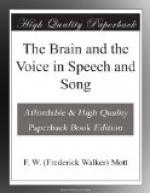intonation cannot be obtained by any effort of the
will. The untaught ability of correct appreciation
of variations in the pitch of notes and the memorising
and producing of the same vocally are termed a musical
ear. A gift even to a number of people of poor
intelligence, it may or may not be associated with
the sense of rhythm, which, as we have seen, is dependent
upon the mental perception of successive movements
associated with a sound. Both correct modulation
and rhythm are essential for melody. The sense
of hearing is the primary incitation to the voice.
This accounts for the fact that children who have
learnt to speak, and suffer in early life with ear
disease, lose the use of their vocal instrument unless
they are trained by lip language and imitation to
speak. The remarkable case of Helen Keller, who
was born blind and deaf, and yet learned by the tactile
motor sensibility of the fingers to feel the vibrations
of the vocal organ and translate the perceptions of
these vibrations into movements of the lips and tongue
necessary for articulation, is one of the most remarkable
facts in physiological psychology. Her voice,
however, was monotonous, and lacked the modulation
in pitch of a musical voice. Music meant little
to her but beat and pulsation. She could not
sing and she could not play the piano. The fact
that Beethoven composed some of his grandest symphonies
when stone deaf shows the extraordinary musical faculty
he must have preserved to bear in his mind the grand
harmonies that he associated with visual symbols.
Still, it is impossible that Beethoven, had he been
deaf in his early childhood, could ever have developed
into the great musical genius that he became.
[Illustration: Fig. 12]
[Description: Fig. 12.—Diagram showing
the position of the larynx in respect to the resonator
and tongue. The position of the vocal cords is
shown, but really they would not be seen unless one
half of the shield cartilage were cut away so as to
show the interior of the voice-box. Sound vibrations
are represented issuing from the larynx, and here they
become modified by the resonator; the throat portion
of the resonator is shown continuous with the nasal
passages; the mouth portion of the resonator is not
in action, owing to the closure of the jaw and lips.
The white spaces in the bones of the skull are air
sinuses. In such a condition of the resonator,
as in humming a tune, the sound waves must issue by
the nasal passages, and therefore they acquire a nasal
character.]
III. THE RESONATOR AND ARTICULATOR




